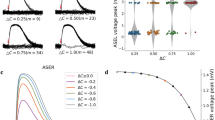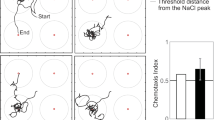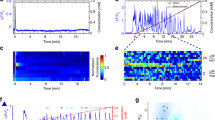Abstract
In this paper, the modeling of several complex chemotaxis behaviors of C. elegans is explored, which include food attraction, toxin avoidance, and locomotion speed regulation. We first model the chemotaxis behaviors of food attraction and toxin avoidance separately. Then, an integrated chemotaxis behavioral model is proposed, which performs the two chemotaxis behaviors simultaneously. The novelty and the uniqueness of the proposed chemotaxis behavioral models are characterized by several attributes. First, all the chemotaxis behavioral model sare on biological basis, namely, the proposed chemotaxis behavior models are constructed by extracting the neural wire diagram from sensory neurons to motor neurons, where sensory neurons are specific for chemotaxis behaviors. Second, the chemotaxis behavioral models are able to perform turning and speed regulation. Third, chemotaxis behaviors are characterized by a set of switching logic functions that decide the orientation and speed. All models are implemented using dynamic neural networks (DNN) and trained using the real time recurrent learning (RTRL) algorithm. By incorporating a speed regulation mechanism, C. elegans can stop spontaneously when approaching food source or leaving away from toxin. The testing results and the comparison with experiment results verify that the proposed chemotaxis behavioral models can well mimic the chemotaxis behaviors of C. elegans in different environments.























Similar content being viewed by others
References
Altun, Z.F., & Hall, D.H. (2006). WormAtlas. http://www.wormatlas.org. Accessed 25 Oct. 2010.
Bargmann, C.I., & Horvitz, H.R. (1991). Chemosensory neurons with overlapping functions direct chemotaxis to multiple chemicals in C. elegans. Neuron, 7(5), 729–742.
Berri, S., Boyle, J.H., Tassieri, M., Hope, I.A., Cohen, N. (2009). Forward locomotion of the nematode C. elegans is achieved through modulation of a single gait. HFSP Journal, 3(3), 186–193.
Bhatla, N. (2009). WormWeb. http://www.wormweb.org. Accessed 26 Mar 2010.
Boyle, J.H. (2009). C. elegans locomotion: An integrated approach. Ph.D. Thesis. University of Leeds.
Boyle, J.H., & Cohen, N. (2008). Caenorhabditis elegans body wall muscles are simple actuators. Biosystems, 94, 170–181.
Boyle, J.H., John, A.B., Cohen, N. (2008). An integrated neuromechanical model of C. elegans forward locomotion. LNCS, 4984, 37–47.
Culotti, J.G., & Russell, R.L. (1978). Osmotic avoidance defective mutants of the nematode Caenorhabditis elegans. Genetics, 90(2), 243–256.
Dunn, N.A. (2006). A novel neural network analysis method applied to biological neural networks. Ph.D. Thesis, University of Oregon, America.
Dunn, N.A., & Lockery, S.R. (2004). A neural network model of chemotaxis predicts functions of synaptic connections in the nematode Caenorhabditis elegans. Journal of Computational Neuroscience, 17(2), 137–147.
Dunn, N.A., Pierce-Shimomura, J.T., Conery, J.S., Lockery, S.R. (2006). Clustered neural dynamics identify motifs for chemotaxis in Caenorhabditis elegans. In International joint conference on neural network (IJCNN 2006) (pp. 547–554).
Ferrée, T.C., & Lockery, S.R. (1998). Chemotaxis control by linear recurrent networks. In Proc. of the sixth annual conference on computational neuroscience: Trends in research (pp. 373–377).
Ferrée, T.C., & Lockery, S.R. (1999). Computational rules for chemotaxis in the nematode C. elegans. Journal of Computational Neuroscience, 6(3), 263–277.
Ferrée, T.C., Marcotte, B.A., Lockery, S.R. (1996). Neural networkmodels of chemotaxis in the nematode Caenorhabditis elegans. Advances in Neural Information Processing Systems, 9, 55–61.
Gray, J.M., Hill, J.J., Bargmann, C.I. (2005). A circuit for navigation in Caenorhabditis elegans. Proceedings of the National Academy of Sciences of the United States of America, 102(9), 3184–3191.
Hamm, L., Wade Brorsen, B., Hagan, M.T. (2002). Global optimization of neural network weights. In Proc. of the 2002 international joint conference on neural networks (IJCNN) (Vol. 2002, pp. 1228–1233).
Iino, Y., & Yoshida, K. (2009). Parallel use of two behavioral mechanisms for chemotaxis in Caenorhabditis elegans. Journal of Neuroscience, 29(17), 5370–5380.
Izquierdo, E.J., & Lockery, S.R. (2010). Evolution and analysis of minimal neural circuits for klinotaxis in Caenorhabditis elegans. Journal of Neuroscience, 30(39), 12908–12917.
Jim, K., Giles, C.L., Horne, B.G. (1996). An analysis of noise in recurrent neural networks: convergence and generalization. IEEE Transactions on Neural Networks, 7(6), 1424–1438.
Karbowski, J., Schindelman, G., et al. (2008). Systems level circuit model of C. elegans undulatory locomotion: mathematical modeling and molecular genetics. Journal of Computational Neuroscience, 24(3), 253–276.
Kawano, T., Po, M.D., Gao, S., Leung, G., Ryu, W.S., Zhen, M. (2011). An imbalancing act: Gap junctions reduce the backward motor circuit activity to bias C. elegans for forward locomotion. Neuron, 72(4), 572–586.
Lari-Najafi, H., Nasiruddin, M., Samad, T. (1989). Effect of initial weights on back-propagation and its variations. In IEEE international conference on systems, man and cybernetics (pp. 218–219).
Lee, Y., Oh, S.H., Kim, M.W. (1991). The effect of initial weights on premature saturation in back-propagation learning. In Proc. of the international joint conference on neural networks (pp. 765–770).
Leung, M.C.K., Williams, P.L., et al. (2008). Caenorhabditis elegans: an emerging model in biomedical and environmental toxicology. Toxicological Sciences, 106(1), 5–28.
Lockery, S.R. (2011). The computational worm: spatial orientation and its neuronal basis in C. elegans. Current Opinion in Neurobiology, 21(5), 728–790.
Maass, W. (1997). Networks of spiking neurons: the third generation of neural network models. Neural Networks, 10(9), 1659–1671.
Pierce-Shimomura, J.T., Morse, T.M., Lockery, S.R. (1999). The fundamental role of pirouettes in Caenorhabditis elegans chemotaxis. Journal of Neuroscience, 19(21), 9557–9569.
Pierce-Shimomura, J.T., Dores, M., Lockery, S.R. (2005). Analysis of the effects of turning bias on chemotaxis in C. elegans. Journal of Experimental Biology, 208(24), 4727–4733.
Piggott, B.J., Liu, J., Feng, Z., Wescott, S.A., Shawn, Xu, X.Z. (2011). The neural circuits and synaptic mechanisms underlying motor initiation in C. elegans. Cell, 147(4), 922–933.
Rankin, C.H. (2005). Nematode memory: Now, where was I? Current Biology, 15(10), 374–375.
Riddle, D.L., Blumenthal, T., Meyer, B.J., Priess, J.R. (1997). C. elegans II. New York: Cold Spring Harbor Laboratory Press.
Saseetharran, M. (1996). Experiments that reveal the limitations of the small initial weights and the importance of the modified neural model. In Proc. of international conference on neural networks (ICNN) (Vol. 1996, pp. 442–447).
Steel, R.G.D., & Torrie, J.H. (1960). Principles and procedures of statistics (pp. 187–287). New York: McGraw-Hill.
Stephens, G.J., Johnson-Kerner, B., Bialek, W., Ryu, W.S. (2010). From modes to movement in the behavior of Caenorhabditis elegans. PLoS ONE, 5(11), e13914.
Suzuki, M., Tsuji, T., Ohtake, H. (2005a). A neuromuscular model of C. elegans with directional control. In Proc. of the first international conference on complex medical engineering (pp. 167–172).
Suzuki, M., Tsuji, T., Ohtake, H. (2005b). A dynamic body model of the nematode C. elegans with a touch-response circuit. In IEEEinternational conference on robotics and biomimetics (ROBIO 2005) (Vol. 2005, pp. 538–543).
Suzuki, M., Tsuji, T., Ohtake, H. (2005c). A model of motor control of the nematode C. elegans with neuronal circuits. Artificial Intelligence in Medicine, 35, 75–86.
Suzuki, M., Goto, T., Tsuji, T., Ohtake, H. (2004). A motor control model of the nematode C. elegans. In IEEE international conference on robotics and biomimetics (ROBIO 2004) (pp. 879–884).
Suzuki, H., Thiele, T.R., Faumont, S., Ezcurra, M., Lockery, S.R., Schafer, W.R. (2008). Functional asymmetry in Caenorhabditis elegans taste neurons and its computational role in chemotaxis. Nature, 454, 114–117.
White, J.G., Southgate, E., Thomson, J.N., Brenner, S. (1986). The structure of the nervous system of the nematode Caenorhabditis elegans. Philosophical Transactions. Royal Society of London, 314, 1–340.
Williams, R.J., & Zipser, D. (1989). A learning algorithm for continually running fully recurrent neural networks. Neural Computation, 1, 270–280.
Wu, Y., & Zhang, L. (2002). The effect of initial weight, learning rate and regularization on generalization performance and efficiency. In Proc. of international conference on signal processing (ICSP) (Vol. 2002, pp. 1191–1194).
Xu, J.X., Deng, X. (2010). Study on chemotaxis behaviors of C. elegans using dynamic neural network models: from artificial to biological model. Journal of Biological Systems, 18, 3–33.
Ye, H.Y., Ye, B.P., Wang, D.Y. (2008). Molecular control of memory in nematode Caenorhabditis elegans. Neuroscience Bulletin, 24(1), 49–55.
Author information
Authors and Affiliations
Corresponding author
Additional information
Action Editor: C. Linster
Rights and permissions
About this article
Cite this article
Xu, JX., Deng, X. Biological modeling of complex chemotaxis behaviors for C. elegans under speed regulation—a dynamic neural networks approach. J Comput Neurosci 35, 19–37 (2013). https://doi.org/10.1007/s10827-012-0437-1
Received:
Revised:
Accepted:
Published:
Issue Date:
DOI: https://doi.org/10.1007/s10827-012-0437-1




